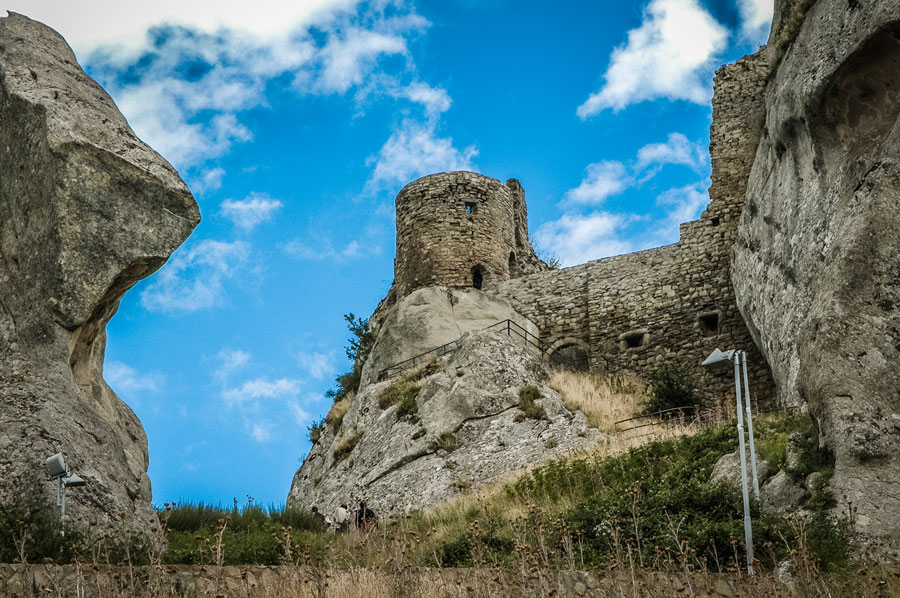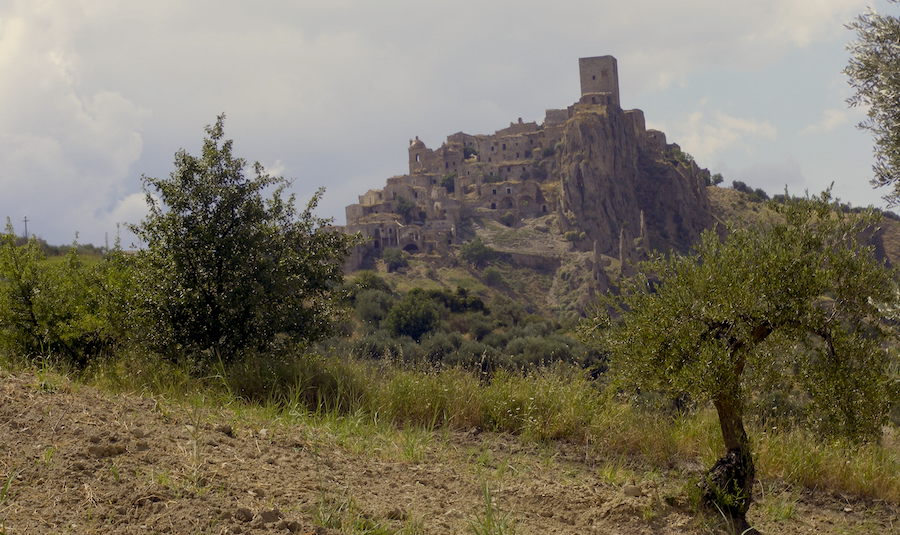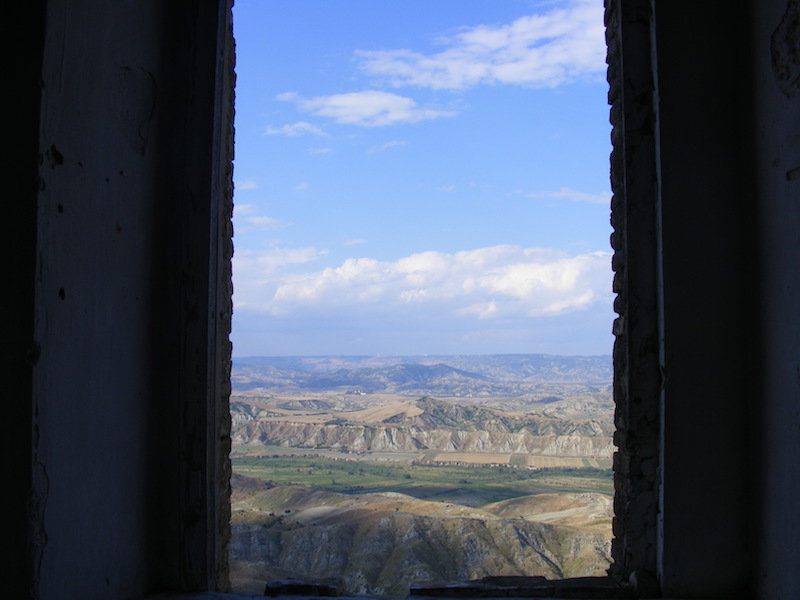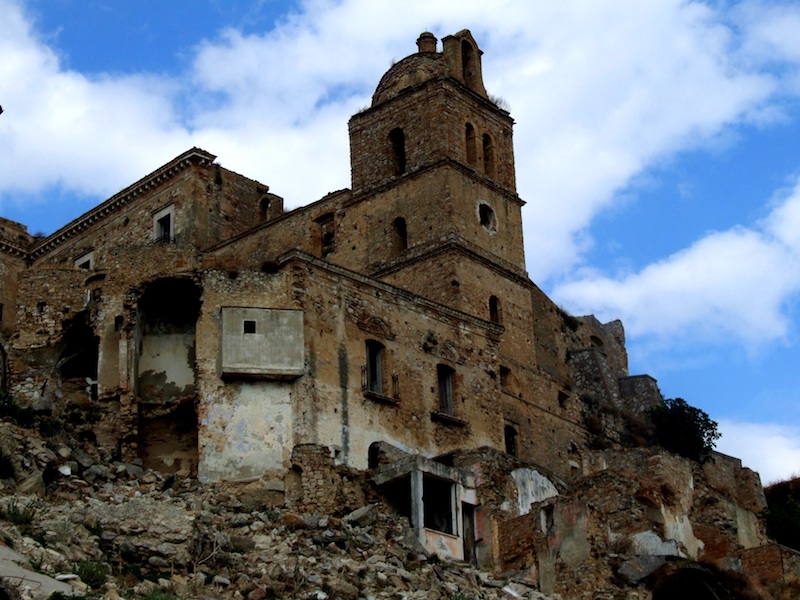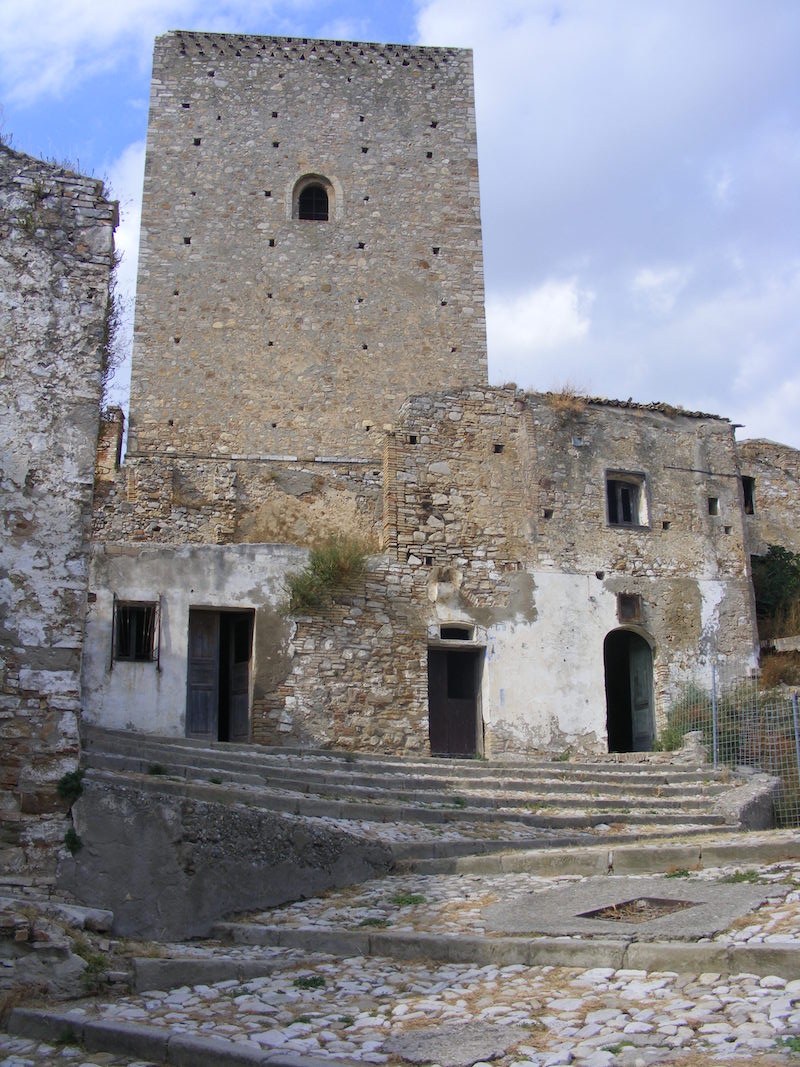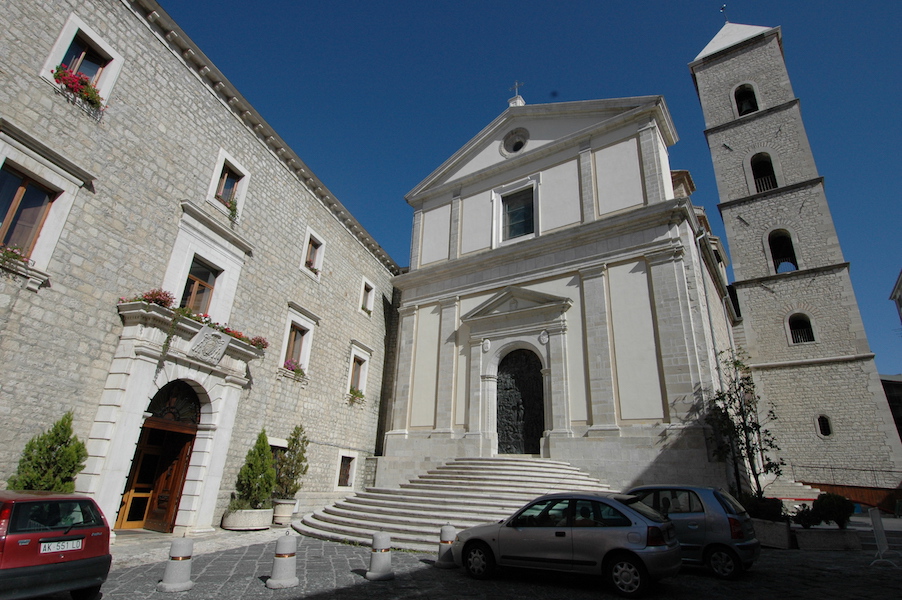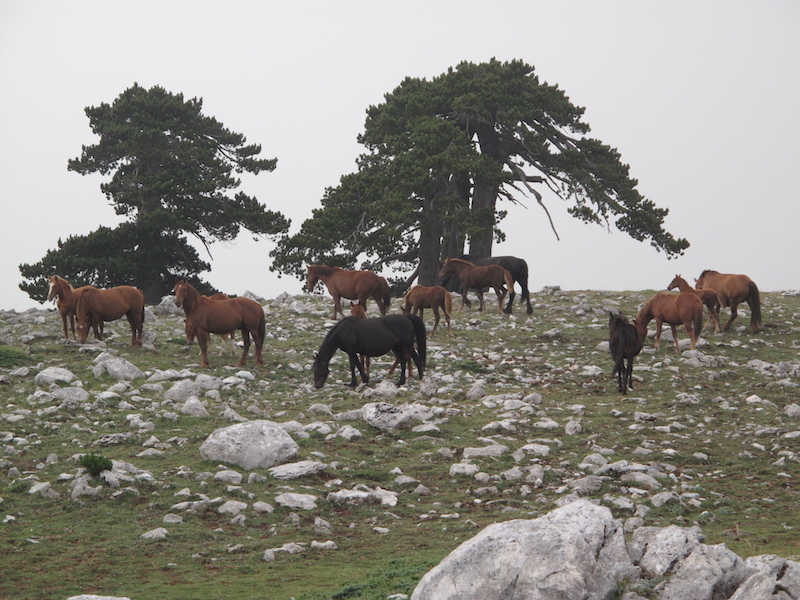idee e itinerari turistici per scoprire la Basilicata
BasilicataDaVedere
Nel silenzio dei calanchi Lucani, tra natura, arte e mistero
Esiste una zona a Sud della Basilicata dove la natura ha creato degli scenari fantastici che ricordano la Cappadocia o i paesaggi dei film western. Stiamo parlando dei Calanchi Lucani: i suoi profondi canyon, le aride dune bianche e i suoi pinnacoli naturali hanno ispirato poeti, pittori e registi che li hanno scelti per la loro unicità e bellezza.
Carlo Levi nel suo Cristo si è fermato a Eboli scriveva “ … da ogni parte non c’erano che precipizi di argilla bianca, su cui le case stavano come liberate nell’aria…”
TAPPE
Tursi - Valsinni - Aliano - Craco - Ferrandina
TEMPO DI VISITA
Uno / due giornate 148 Km
QUANDO
Tutto l’anno. Preferibilmente da Marzo a Ottobre per chi volesse fare l’itinerario in un’unica giornata
IL NOSTRO CONSIGLIO
Non si può non mangiare il peperone “Crusco” di Senise condito con l’olio DOP di Ferrandina
COME
In auto e a piedi
PARTENZA E PRIMA TAPPA: TURSI
Punto di partenza del nostro tour è Tursi. Il paese, che ha dato i natali al poeta Albino Pierro due volte candidato al premio Nobel, è sovrastato dalla Rabatana. La Rabatana , di origine Saracena, è un groviglio di case, vicoli, archi, gradinate tortuose che portano a profondi precipizi e grotte.
La passeggiata tra i vicoli ci porterà alla chiesa Santa Maria Maggiore in Rabatana dell'XI sec. Ai piedi della Rabatana si sviluppa la restante parte del centro storico collegata da una ripida scalinata chiamata a’ petrizze.
SECONDA TAPPA: SANTUARIO DI SANTA MARIA DI ANGLONA
Lasciata Tursi è consigliata una sosta al Santuario di Santa Maria di Anglona. Edificato fra il XI e XIII secolo è un vero capolavoro dell’arte sacra medioevale. Dalla collinetta su cui sorge è possibile vedere lo scenario che ha fatto da sfondo ad un’epica battaglia avvenuta nel 208 A.C., la battaglia di Herakleia che ha visto combattere i romani contro gli elefanti di Pirro.
TERZA TAPPA: VALSINNI
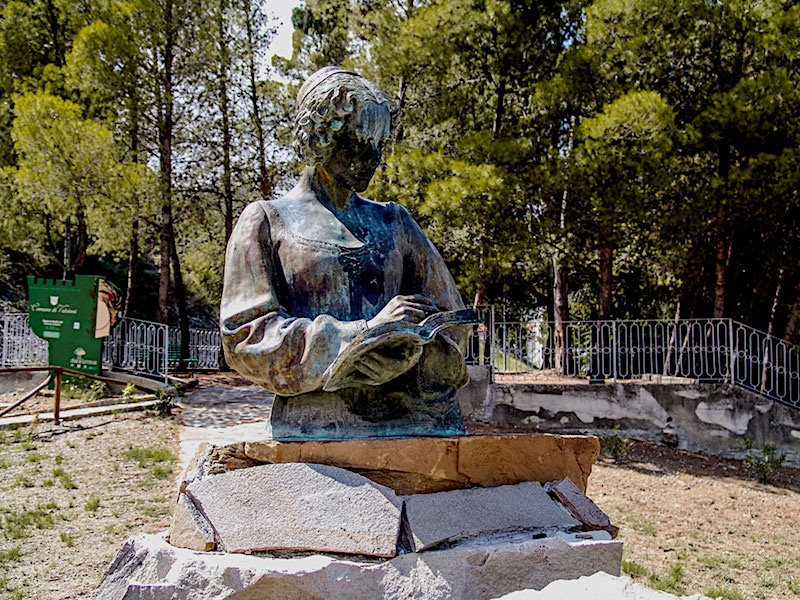
Riprendiamo il nostro itinerario direzione Valsinni la cui fama è legata al tragico destino della poetessa Isabella Morra, a cui è dedicato il parco letterario del paese che permette ai visitatori di ripercorrerne la storia attraverso le sue poesie.
Anche Valsinni, che ha ricevuto dal Touring Club la Bandiera arancione, marchio di qualità turistico-ambientale, ha un centro storico caratterizzato da vicoli e passaggi coperti da volte a botte chiamati “gafi”. Meritano una visita il castello, la Chiesa Madre e Palazzo Mauri.
QUARTA TAPPA: SENISE
Lasciata Valsinni facciamo rotta verso Aliano. Lungo la strada incontreremo la diga di Monte Cutugno, una delle più grandi opere in terra battuta d’Europa dove si svolgono gare internazionali di canottaggio e dove in estate si tiene l'imponente spettacolo "Magna Grecia. Il mito delle origini".
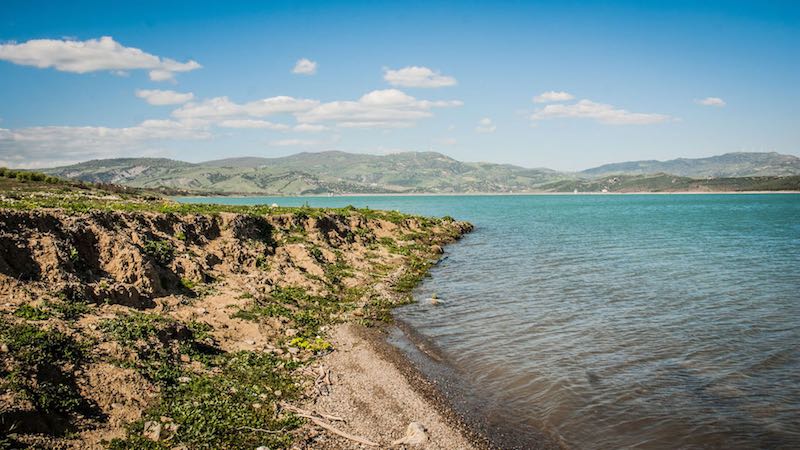
A due passi dal lago c'è Senise, patria del peperone Crusco e Sant’Arcangelo con il suo Convento di Santa Maria di Orsoleo, uno dei più importati monumenti religiosi della Basilicata risalente al 1400.
QUINTA TAPPA: ALIANO
La SS 92 che si snoda tortuosamente lungo i Calanchi ci porta ad Aliano. Si va così vicini a guglie e pinnacoli che sembra quasi di toccarli. Aliano è un piccolo paesino arroccato su un costone argilloso circondato da profondi precipizi.
Il suo nome è legato alla figura di Carlo Levi che fu confinato per 8 mesi durante il periodo fascista. Oltre al Parco letterario e al museo ricavato nell’abitazione che ha ospitato lo scrittore, merita una visita la Chiesa di San Luigi Gonzaga.
SESTA TAPPA: CRACO
Terminata la visita di Aliano riprendiamo la strada verso Craco, un paese fantasma abbandonato nel 1969 a causa delle continue frane. È proibito entrare nell’abitato senza affidarsi ad una guida (le trovate sul sito del comune) a causa di possibili crolli ma il colpo d’occhio dall’esterno è davvero eccezionale e lo scenario che circonda il borgo è davvero unico, tant’è che alcuni registi lo hanno scelto per girare alcune scene di film. Il più recente è stato La passione di Mel Gibson che vi ha ambientato la scena dell’impiccagione di Giuda.
Ma al nome di Craco, che nel 1276 divenne sede universitaria, è legata una leggenda sui Templari: vi si racconta che vi giunse ferito San Vincenzo martire insieme con San Maurizio proprio dopo un o dei viaggi in Terra Santa nel periodo delle Crociate.
Nel 2010 il suo patrimonio storico-artistico è stato inserito nella lista dei luoghi da salvare del World Monuments Funds.
ULTIMA TAPPA: FERRANDINA
Il nostro itinerario termina con Ferrandina fondata nel ‘400 da Federico e Isabella d’Aragona.
Il paesino è un suggestivo intreccio di casette bianche dalle facciate strette, scalinate e vicoli. Da visitare la Chiesa Madre dedicata a Santa Maria della Croce, la chiesa Di San Domenico, la chiesa del Purgatoio e la chiesa della Madonna dei Mali.
http://www.basilicatadavedere.com/it/blog/itemlist/user/288-basilicatadavedere#sigProIda4c4b4079e
A day in Matera: the city of Sassi
Matera , known to most as the city of the Sassi , is an unique place that offer unforgettable emotion. Its beauty has inspired moviemakers as Pasolini (Il Vangelo secondo Matteo) and Mel Gibson (The Passion) that they used as a film set for numerous films.
WHAT ARE “I SASSI”?
I Sassi, declared a world heritage site by UNESCO in 1993, are the historic center of the city of Matera , with their particular twist of caved used as houses, alley, stone churches, terraces, gardens, tunnel, are a great example of an architectural complex perfectly matching with the natural environment.
I Sassi are divided into two districts, the Sasso Barisano and Sasso Caveoso. The Sasso Barisano, the biggest, is characterized by the presence of shops, restaurants and hotels while the Caveoso is the oldest neighborhood that best preserves the appearance of the cave city.
To appreciate in full their uniqueness let visit I Sassi on foot, lost in the alleys, stairs and panoramic squares from which to enjoy the beautiful landscape.
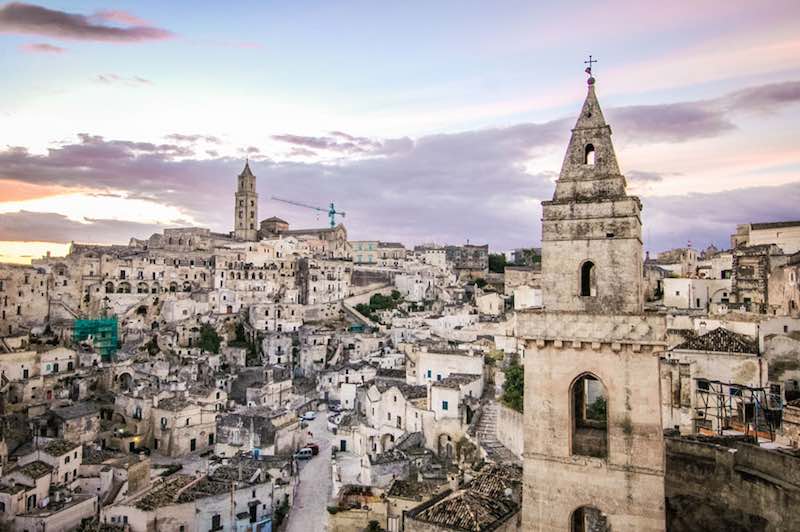
Time of visit
3 hours for a quick sightseeing of Sassi but we recommended to dedicate the whole day in Matera to visit Museums and the park of cave churches
Recommended period
All the year
Tips
the visit of Matera is for all people who love to see a unique place
Our advice
STARTING POINT: PIAZZA PASCOLI
A visit of Matera could start from Piazza Pascoli, a natural window to enjoy an amazing view of the two Sassi districts, from here you can walk to explore several historically and artistically sites. A tour of Matera has five things to see Matera otherwise you can not leave Matera.
FIRST STOP: CASA NOHA
The ancient house, close to the Cathedral, is an historic house museum where the use of original furnishings allow us to understand how people lived in those environments in the past. A documentary is is projected on the stone walls of the house, telling the story of the city from prehistory to today.
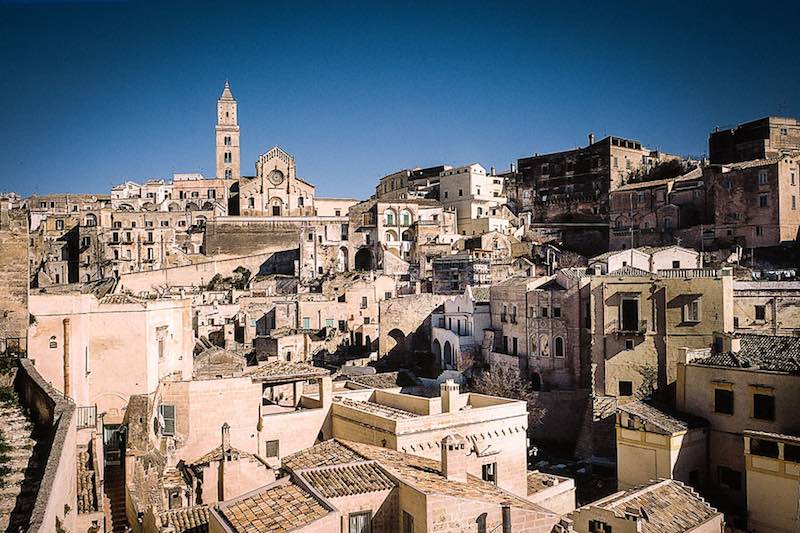
SECOND STOP: PIAZZA SAN PIETRO CAVEOSO
The cave church of St. Peter gave the named to this square. The church stands on a block of stone that gives a fantastic view on the canyons of the Gravina, one of the typical landscapes of the Murgia.
THIRD STOP: Cave CHURCHES Madonna dell’Idris e San Giovanni
Santa Maria de Idris church dug into the side of Monterrone, and St. Giovanni crypt that forms, through an internal passage, a beautiful rupestrian complex.
The rupestrian churches with their architectural virtuosity and their decorations are exceptional works of art, expression of the historical – cultural territory. You can find greek-orthodox churches close to latin churches that testify the cultural and architectural development level reached by the rupestrian community.
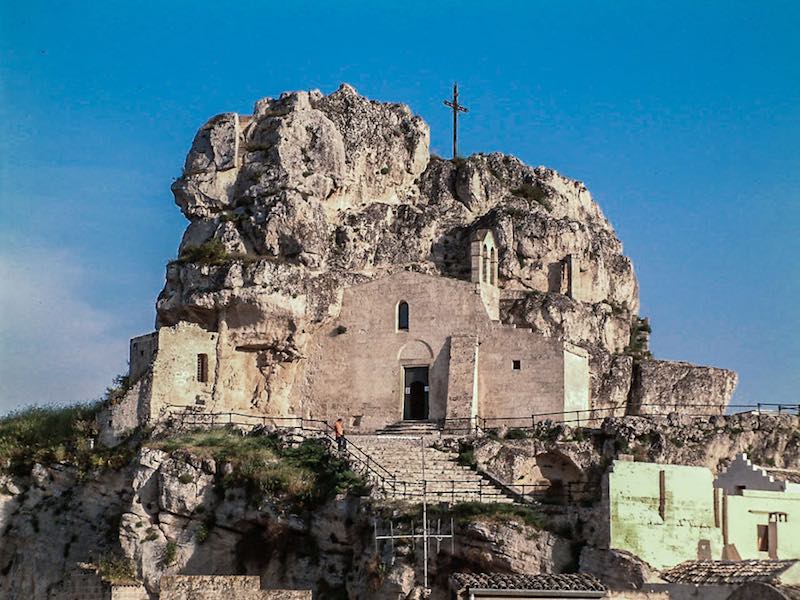
There are almost 150 churches in the Matera area for the protection of which it has been established the Park of the Rupestrian Churches of Matera, UNESCO World Heritage Site.
FOR FURTHER INFORMATION PLEASE READ OUR PAGE ABOUT MATERA!
FOURTH STOP: THE CATHEDRAL
On the top of the hill, Civitas hill, there’s the Cathedral which offers an amazing view of the “Sasso Barisano”.
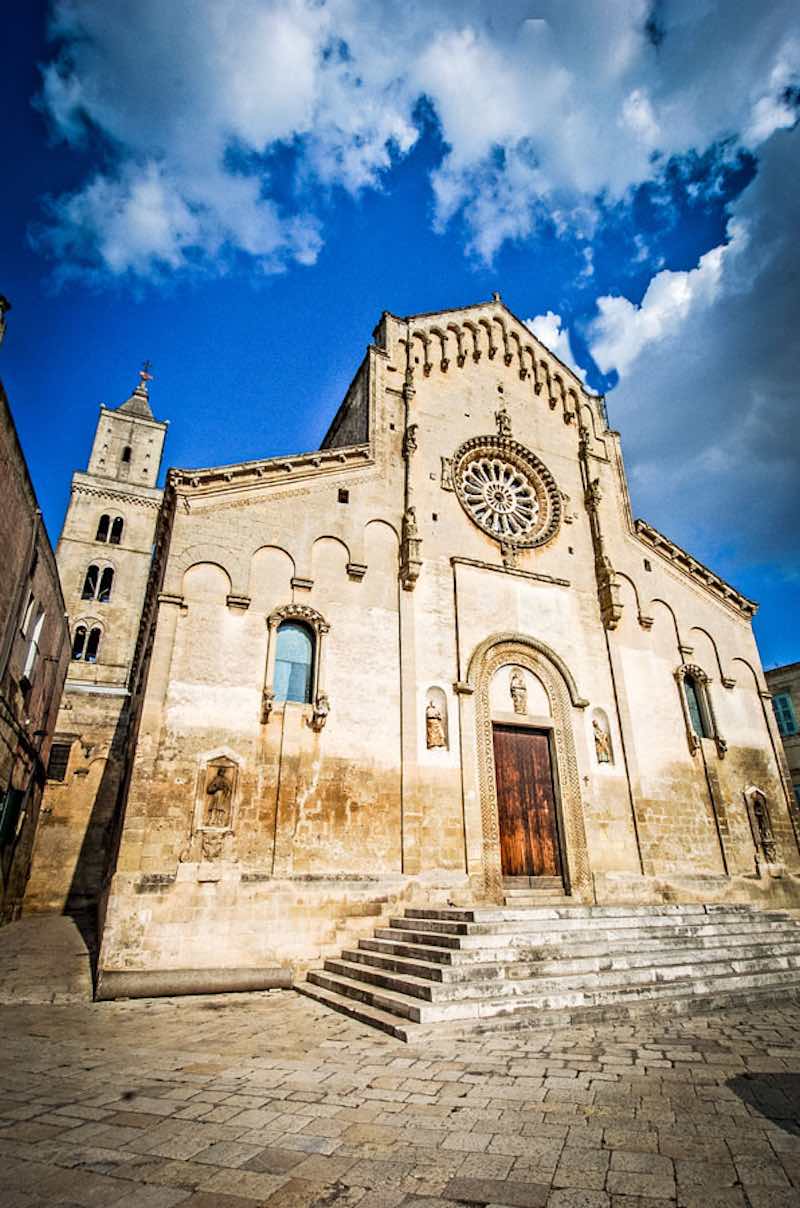
The Cathedral of Madonna della Bruna and Sant'Eustachio, Apulian-Romanesque style, was built in the thirteenth century. The façade of the church has beautiful decorated portal: you can see an impressive rose window with 16 rays (symbol of the wheel of life)
Take time to visit the Church of St. Francesco d’Assisi and the Church of Purgatorio.
FIFTH STOP: CRYPT OF THE ORIGINAL SIN
The Crypt of the Original Sin is 14 kilometers from Matera. It’s a frescoed church cave the town, known as the "Sistine Chapel". The painting show episodes from Genesis , Apostles, Archangels and the Virgin.
The extraordinary painting complex (sec. VIII – IX) that decorates the walls of the crypt is undoubtedly one of the most important examples of early medieval painting in the Mediterranean.
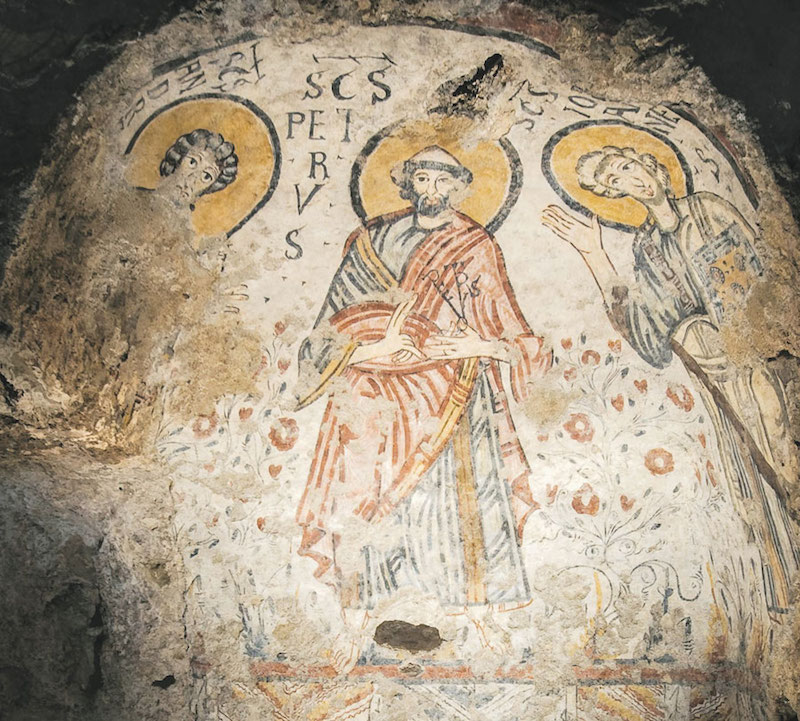
TO SEE BEFORE YOU LEAVE ... MATERA
If you still have time Matera has museums that may be included in the city tour. You can choose from the National Archaeological Museum "Domenico Ridola", the National Museum of Medieval and Modern Art and Musma, Museum of contemporary sculpture.
IF YOU LIKED THIS TOUR, YOU CAN ALSO READ OUR ITINERARY IN THE HEARTH OF POTENZA!
http://www.basilicatadavedere.com/it/blog/itemlist/user/288-basilicatadavedere#sigProIdfedec3abca
In the "heart" of Potenza town
A street, named Via Pretoria, identify the historic center of Potenza. Since the center is located on a hill the people of Potenza (called "potentini") are you used to say see you "Sopra Potenza (on top of the hill). We will walk along this street to discover churches, palaces, shops, squares.
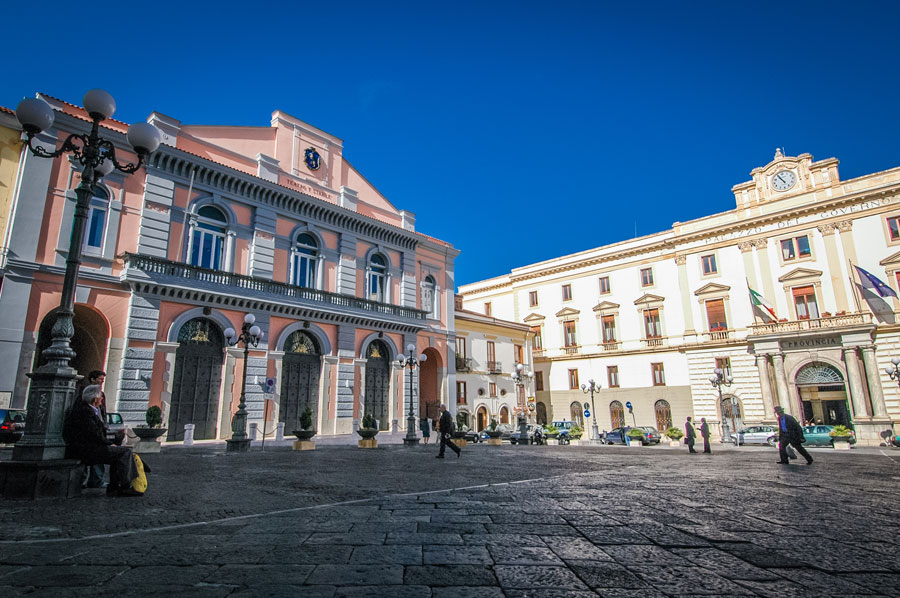
Time of visit
Half a day for the city center or the whole day for see the place out the city center
Recommended period
All the year
Tips
For those who loved culture and history
FIRST STAGE: HISTORIC CENTER
Let starts from Porta Salza, one of the three doors remained to the present day, and the first stop is the Church of San Michele Arcangelo, a splendid example of Romanesque art. Inside are preserved two relevant paintings of local painters: L’Annunciazione e La Madonna del Rosario of Pietrafesa and Quindici Misteri of Antonio Stabile.

After the visit of the church we get to Piazza Mario Pagano, the square of Potentini, and home to the lovely Teatro Stabile and the church and convent of St. Francis of the thirteenth-century.
We continue our pleasant walk among the shops, palaces and small squares to reach the Cathedral of St. Gerardo twelfth century. Very nice is the façade with a portal with two bronze doors, inside of considerable value is the chapel of St. Gerard and the crypt close to the altar.
Leaving the Cathedral a visit of the National Archaeological Museum Dinu Adamesteanu is recommended, it will offer an overview of archeological reality of Basilicata that it was a meeting place of different culture.
Our journey through the old town ends with Torre Guevara, a witness to the presence of a castle, the ruins were finally removed in the 60's, but you can not leave without tasting the "pizzetta", (a small pizza with tomato) of Mr. Lovaglio in Piazza Matteotti near of the shrine of St. Gerard, the patron saint of the city.
FOR FURTHER INFORMATION PLEASE READ OUR PAGE ABOUT POTENZA!
WHAT TO SEE AT THE HISTORICAL CENTER OUT
If you still have time we recommend a visit to the Church of Santa Maria del Sepolcro, in the district of Santa Maria, and Musumeci Bridge, built by the homonymous engineer in the late '60s; the bridge does not have pillars but waves of cement.
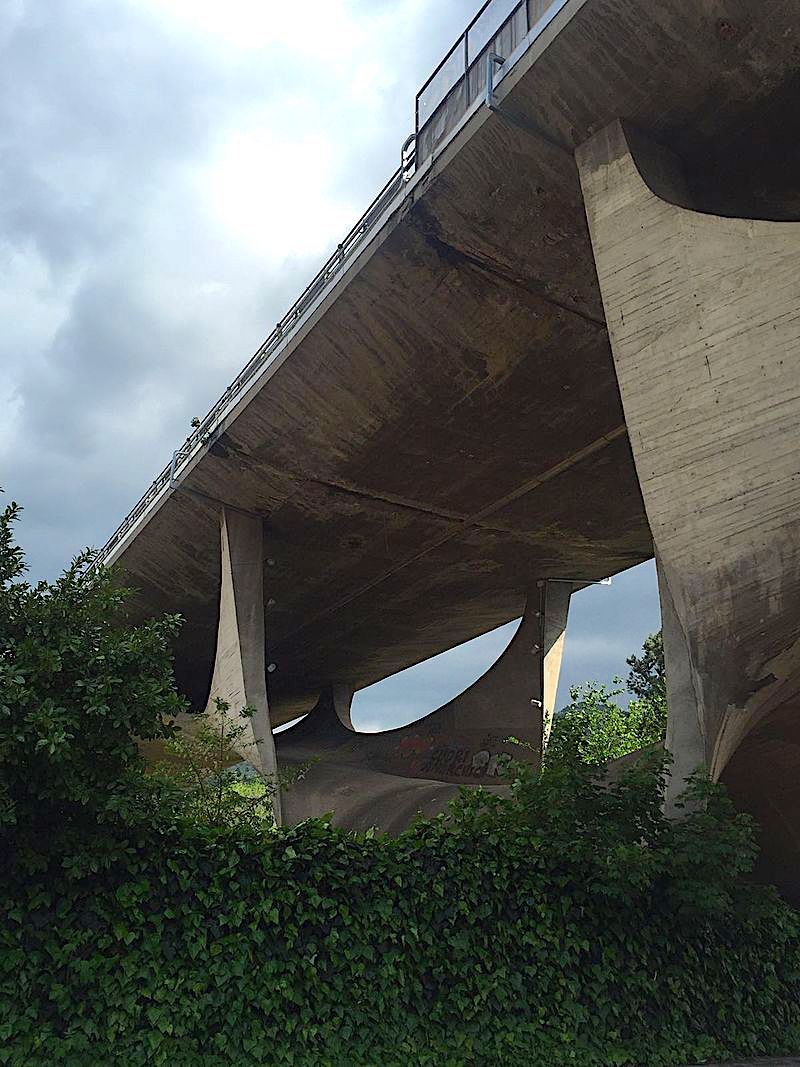
IF YOU LIKED THIS TOUR, PLEASE READ ALSO OUR ITINERARY TO DISCOVER MATERA, THE CITY OF "SASSI"!
http://www.basilicatadavedere.com/it/blog/itemlist/user/288-basilicatadavedere#sigProId2aeb799f69
What to see in Viggiano
Nature, sporta and sacredness fuse together in this little mountain town of Basilicata. Located at an altitude of nearly 1000 metres, Viggiano is the ideal destination for skiing lovers. Here there is the Montagna Grande (Big Mountain), massif of the Lucanian Apennine at about 1700 metres AMSL, equipped with skiing facilities and accommodation.
THE BLACK VIRGIN MARY, PATRON SAINT OF BASILICATA
And it is also here, in the heights between the beech woods, that you can find the Santuario della Madonna Nera del Sacro Monte di Viggiano (the Black Virgin Mary of the Holy Mount of Viggiano Shrine), destination of pilgrimages and worship. The Shrine hosts, between May and September, the ancient wooden statue of the Black Virgin Mary, patron saint of Basilicata.
Visiting Viggiano and its mountains also means savouring the typical dishes of the Lucanian cuisine and living a weekend in touch with the nature..
The village of Viggiano is in fact located inside the Lucanian Apennine-Val d'Agri-Lagonegrese National Park, a privileged place for trekking lovers who there can visit the WWF Theme Museum about the history of the Italian Wolf (also known as the Apennine Wolf).

THREE GOOD REASONS TO VISIT VIGGIANO
1. THE SKI RESORT
The ski resort Montagna Grande of Viggiano is about 11 kilometres from the village, between the mountains of the Lucanian Apennine.
It contains three slopes for Alpine skiing, located between 1400 – 1600 metres AMSL and with a layout for cross country skiing loop-shaped that is 3 kilometres long and enters the beech wood from the downstream area of the Alpine ski slopes.

The slopes are supplied with two skilifts and a conveyor belt suitable for less-experienced users; they make carving skis, boots, helmets, bobsleighs and little sledges available for hire. The structure is equipped with night lighting, to allow the skiers to try the thrill of skiing in the moonlight (night opening is only in particular occasions).
Close to the ski area there are many paths where you can walk by snowshoes or by horse drawn sleighs.
2. THE LUCANIAN APENNINE NATIONAL PARK
When the green of woods substitute for the white of snow, the Montagna Grande of Viggiano changes its aspect and gives the tourist a new experience. The massif is in fact inside the Lucanian Apennine National Park, a place full of fauna and flora to discover by trekking and nordic walking following its numerous paths.
Inside the Park, what deserves a visit is undoubtedly the WWF Theme Museum about the Apennine Wolf (free entrance), where it is possible to follow interesting documentaries and classes with the experts of the Educational and Environmental Centre of Viggiano.
3. THE PILGRIMAGE OF THE BLACK VIRGIN MARY
The pilgrimage towards the Black Virgin Mary Shrine is one of the most heart-felt religious recurring event from Lucanian people. It occurs in two periods of every year: the fist Sunday of May and the first Sunday of September.
In May, a solemn procession carries the statue from the Church of Viggiano to the Shrine on the sacred Mount, located 12 kilometres away from the village at a high of 1725 metres.
Then in September, the statue makes the return journey the opposite way to come back to the sacred Mount of the mother-church of Viggiano. Reaching the Shrine is not easy, since the path is uphill and people need to pass through two kilometres of beech woods and breath-taking views. Once on the top, though, the sensation of peace and the sacred aura surrounding the Shrine pay even the most sceptical back for the long walk.

Since August 2016 visitors of Viggiano have been able to admire the imposing monument dedicated to the statue carriers, realised by the artist Felice Lovisco. The holy work is the second biggest in Basilicata after the Christ statue in Maratea, and it is exactly located in Piazza Giovanni XXIII.
What to see in Venosa
"Carpe diem, quam minimum credula postero" ("Seize the day, put very little trust in tomorrow")... The verses of Orazio echo in the streets of Venosa, the Lucanian town that gave birth to the famous Roman poet in 65 b.C. A few steps away from the town you can find the remains of the ancient Roman city whereas around the lanes of Venosa the visitor can go in search of the house that, according to the tradition, was the poet's.
A JOURNEY IN THE TOWN OF HORACE AND DON GESUALDO
Venosa tells also a story of music, passion and death: it is the story of Prince Gesualdo from Venosa, madrigal composer in the XVII century. He was forced to run away from Venosa because of having murdered his unfaithful wife Maria and her paramour.
There is also the story of the "unfinished", the XI century abbey that was meant to become huge but it is to this day only mysterious walls and a roof of stars. Venosa is a city able to tell stories to be listened to while drinking Aglianico del Vulture, exquisite Lucanian red wine that originates in these areas.
For all these reasons, Venosa is one of "The Most Beautiful Hamlets in Italy".

THREE GOOD REASONS TO VISIT VENOSA
1. A JOURNEY IN THE HISTORY
The first thing to see when you visit Venosa is the Castle of Pirro del Balzo (photo in the gallery), dated back to 1470, which is erected majesticly in the town centre and houses the National Archeological Museum.
Backwards in time, a few steps away from Venosa there is the beautiful abbey of Santissima Trinità, inside of which you can find precious frescoes and the remains of the Norman mercenary captain Roberto il Guiscardo. What is going to strike the visitor is undoubtedly what remains of the one called "L'Incompiuta" ("The unfinished"), located on the back of the abbey.
Building works, started in the XI century, aimed to complete the abbey with a huge apse and two large spans, but this never happened. Today the visitor can walk in the middle of the suggestive remains of this dream never fulfilled.

Other proofs of the holy in Venosa are the Christian catacomb of the IV century and the Jewish ones of the III-IV century.
By staying in the past, the Archeological Park shows the republican period of the city and, hidden among the town lanes, we can find out the house that, according to the tradition, was the Horace's one.
DISCOVER OUR ITINERARY TO VISIT VENOSA AND ACERENZA, BETWEEN CULTURE AND MYSTERY
2. THE TASTE OF AGLIANICO
Venosa is one of the localities of Basilicata that are the birthplace of the famous Aglianico del Vulture, considered as one of the best italian red wines. This wine, the vine variety of which grows on the slopes and the valley of the extinct volcano Vulture, has a ruby garnet red that acquires orangish highlights with the ageing.
To the sense of smell it is possible to recognise notes of blackberry and wild plum, violet and strawberry; the ageing adds perfumes of liquorice, dark chocolate, black pepper. At the taste, the Aglianico del Vulture turns out to be full bodied, with a moderately tannic and fresh structure and with 12,5 -13,5 % alcohol.

DISCOVER ALSO OUR ITINERARY "ON THE VULTURE TO TASTE AGLIANICO WINE"
3. DISCOVERING OUR FOREBEARS
Near Venosa it is possible to visit the Paleolithic Site of Notarchirico - one of the most ancient of Europe, dating back 600.000 years ago. Its importance is highlighted by the discovery, in 1985, of a human thigh-bone that probably belonged to a Homo erectus and it is one of the most ancient fossil remains of Europe.
The entrance ticket is combined with The Archeological Park, The Jewish Catacombs and the National Archeological Museum's ones.
http://www.basilicatadavedere.com/it/blog/itemlist/user/288-basilicatadavedere#sigProId5dc82035e7
What to see in Valsinni
A few kilometres away from the Pollino National Park there is this enchanting hamlet that offers a unique panorama on the valley and a story to tell. It is one of those sad tales which the inhabitants tell while they direct their glance on the ancient castle that today still overlooks Valsinni.
THE VILLAGE, SCENE OF A SAD AND SENTIMENTAL STORY
Here in 1520 Isabella Morra was born; great poetess and woman of extreme emotional sensitivity. The poor wretch was savagely murdered by her brothers, lords of Valsinni at the age of only twenty five years old, because of an alleged clandestine affair with Diego Sandoval de Castro, Spanish poet and baron, lord of the close feud of Bollita and married to baroness Antonia Caracciolo.
The young poetess' death has never been forgotten by people of Valsinni, who established a Literary Park in her honour.
Valsinni is not only this, though. The hamlet is an evocative maze of alleyways and tiny streets, where both the mother-church dedicated to Maria Assunta and Palazzo Mauri with an antique mill inside, stand out. For these reasons Valsinni is one of the towns awarded as Orange Flag by the Italian Touring Club, certification that rewards hinterland small towns standing out for excellence and qualitative hospitality.
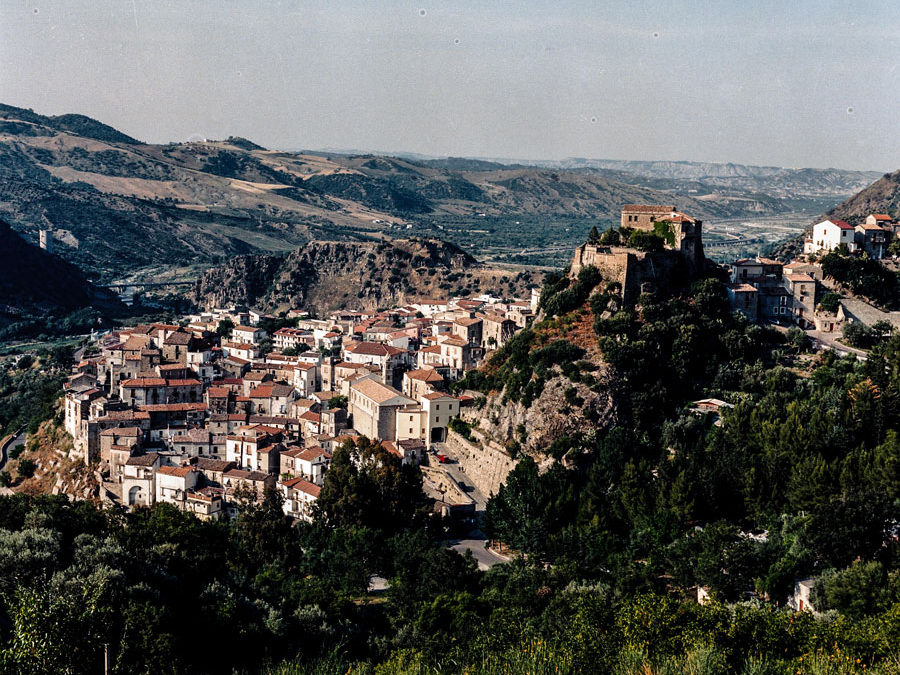
THREE GOOD REASONS TO VISIT VALSINNI
1. THE LITERARY PARK
If you love poetry and romanticism, then Valsinni is the right place to visit. The Literary Park "Isabella Morra" recalls the sad story of the poetess, thanks to actors with stage costumes and minstrels who recite her poetry, allowing the audience to relive this girl's tragic sequence of events.
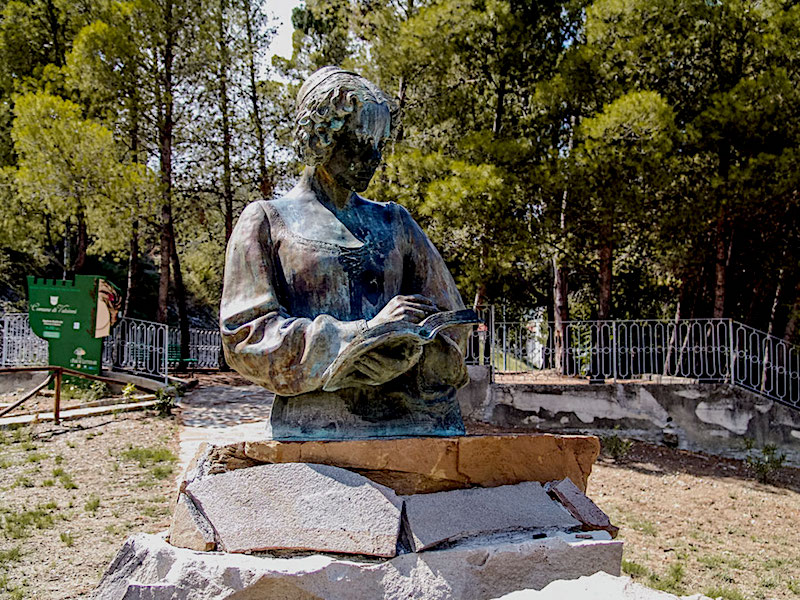
This is an authentic dive into the past between poetry, music and genuine flavours. You cannot miss a visit to the castle (guided), to Mauri Palace and to the mother-church, which safeguards a precious wooden crucified Christ, dated back to the XV century.
2. THE MYSTERY OF ISABELLA MORRA
The relationship between Isabella e Diego was probably just an epistolary one: a bond between two sensitive souls finally joined in a brutal world. For this reason, Isabella's story is different from the many of barbarity connected to an obscure sense of honour. It is told that the poetess ghost has never found peace and keeps meandering around the castle walls where she was stabbed to death.
Still to this day, many people claim to have met her, barefoot and wearing a long white dress, while she melancholically admires, from the top, the gorgeous panorama of the valley eulogised in her poetry.
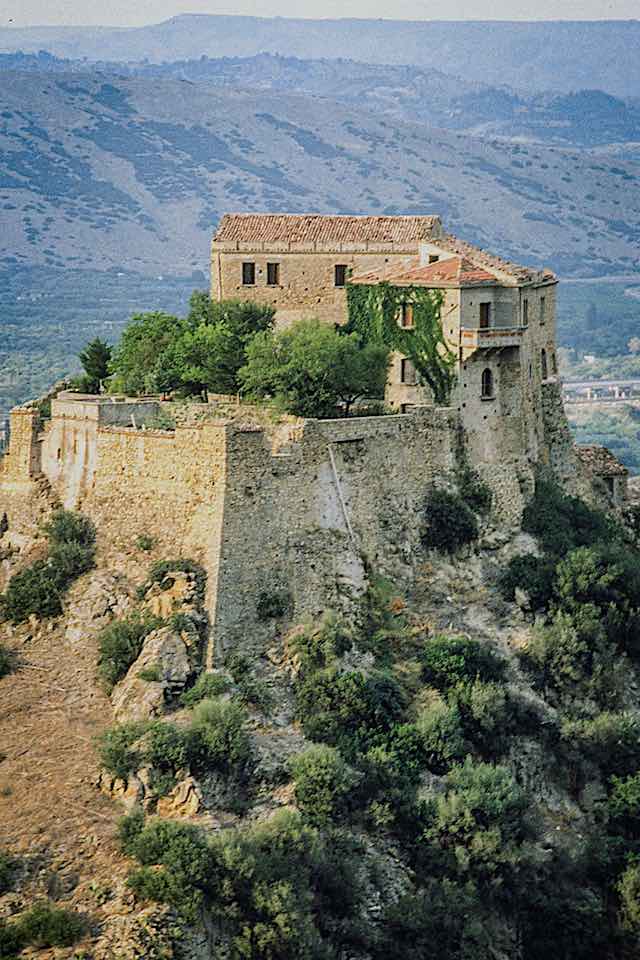
3. THE "PUPARULI CRUSCHI"
Seeing Valsinni does not mean only taking a journey between poetry, culture and mystery. As every other village in Basilicata, this one as well has its own delicious recipes and high quality food.
Prince of the table is the Igp pepper of Senise (town a few kilometres away from Valsinni), which is savoured dried to give life to the traditional "puparuli cruschi": they are sundried crunchy peppers that can be eaten raw or cooked with strascinati (a particular handmade pasta), grated cacioricotta cheese and soft crumbs to create one of the typical dishes of the Lucanian tradition.
What to see in Senise
The yellow ochre of sand and the green of woods combine with the bluest of waters to leave an indelible memory in the eyes of the visitor seeing Senise for the first time. It is here that the Monte Cotugno dam was built, one of the major works in Europe in clay. It slows down the flow of the River Sinni and creates an artificial lake of extraordinary beauty.
THE SHOW ON THE LAKE WATERS
Here the historical theme park "Magna Grecia. Il mito delle origini" rises up, a show dedicated to the landing of the Ancient Greeks at Basilicata. It is a majestic performance, with historical reenactments and hundreds of actors and extras supervised by the famous director Emir Kusturica.
After a stop-over at the lake we suggest that you visit the town of Senise, full of tangled alleys which lead to the castle - built in 1200 and reconstructed two centuries after. You cannot miss the ethnographic museum, the ancient noble palaces and the church of San Francesco, dated back to XIV century.
At the end of the day, after spending the morning at the lake and the afternoon in town, you can stop to taste these places' delicacies such as the IGP peppers and the Grottino di Roccanova, IGT red wine - the name of which refers to the typical caves dug into the sandstone where barrels used to be kept.
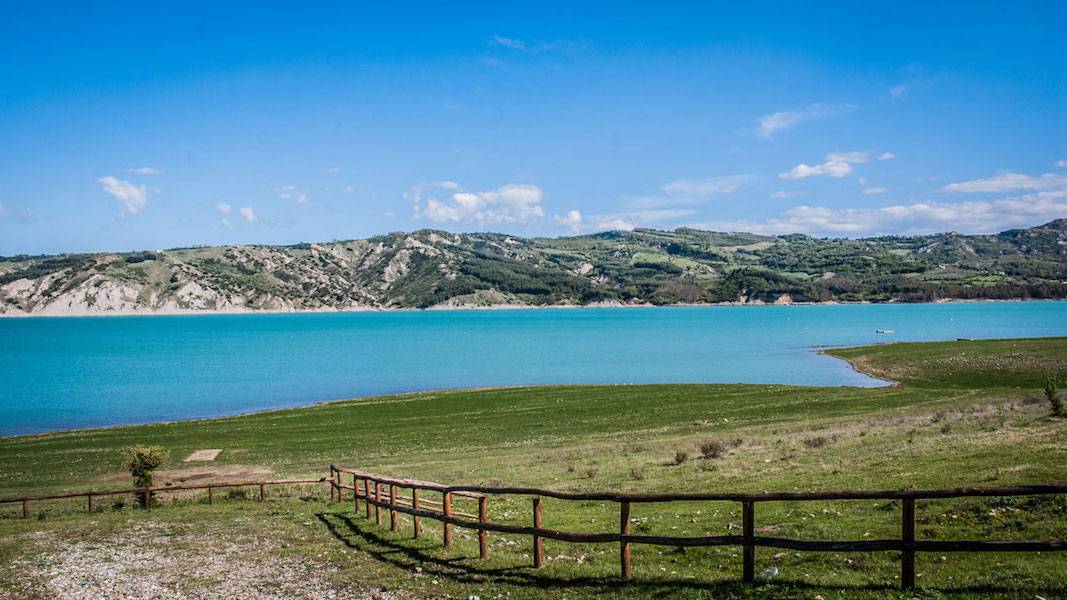
THREE GOOD REASONS TO VISIT SENISE
1. SUNDRIED CRUSCHI PEPPERS
If you want to try typical Lucanian dishes you cannot avoid stopping in Senise. The origins of the sundried cruschi peppers are right here and they represent one the most typical foods of the regional cuisine.
Senise IGP peppers are dried out until they become crunchy ("cruschi", in dialect) to be used in numerous recipes such as with salted codfish or with strascinati (a particular handmade pasta), soft crumbs and cacioricotta cheese (we advise you to try them!).
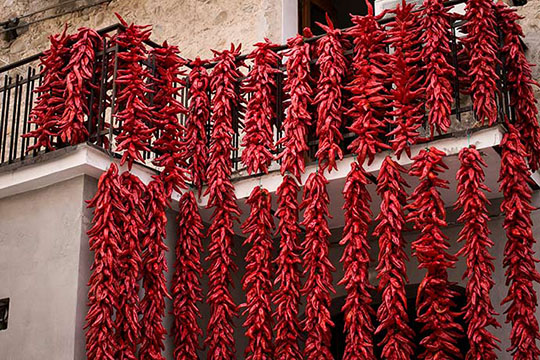
The huge celebration "Strittul ru Zafaran" (the alley of peppers) is dedicated to the Cruschi peppers in August: there it is possible to taste this food in all its combinations, together with a glass of Aglianico del Vulture or Grottino di Roccanova, IGT wine produced in these places.
2. LAKE FISHING
The lake of Monte Cotugno is an ideal place to play sports that are in touch with nature. It is an important point of reference for sporty fishing lovers, who can find refreshment in the local holiday farms.
The immense stretch of water is also a scene of meetings and national rowing competitions.
3. THE SHOW OF MAGNA GRECIA
Shining armours, ancient gods, ships and monsters: during the summer the lake waters embellish themselves with lights for "Magna Grecia: il mito delle origini", a "cinespettacolo" dedicated to the landing of the Ancient Greeks at the Ionian coasts of Basilicata.
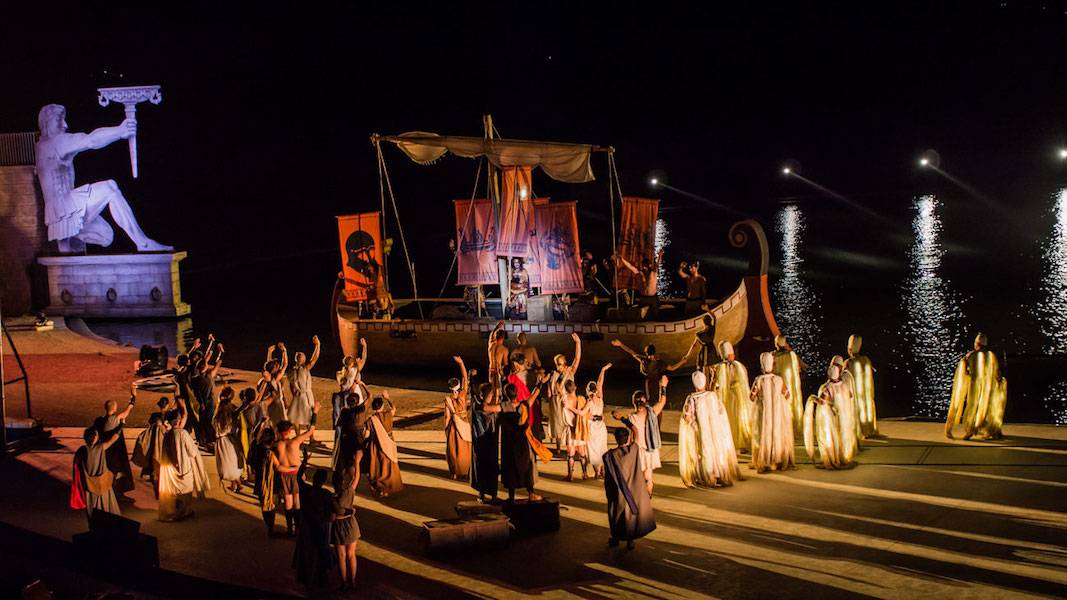
A journey around Senise is also a journey in the antique artisan and farming culture, described in the Ethnographic Museum of Senise, sprung in 2003. Farming tools, aged clothes, things of everyday usage and photographic materials tell us stories of a past that seems to be very far away.
http://www.basilicatadavedere.com/it/blog/itemlist/user/288-basilicatadavedere#sigProId0abef5f4a9
What to see in Rotonda and on the Pollino massif
By discovering the small town of Rotonda, Basilicata visitors have the chance to start a journey in a majestic and uncontamined nature. It is from this village in fact that the most important paths branch off to discover the Pollino National Park which is currently the largest natural park in Italy, with its 192.000 hectares.
DEEP INTO THE UNCONTAMINED NATURE
Mountain paths between woods and brooks; walks on the pure white snow; exciting descents onto tumultuous creeks: Pollino is the favourite place for those who love nature, sports and adventure. And then, there is the rare Bosnian pine - the tree that is the symbol of the park and that, with its twisted shapes, represents an authentic monument carved in the nature. The “Patriarca”, as the oldest pine is called, is more than 900 years old!
A legendary, ancient, ancestral place is the Romito Cavern, with its prehistoric graffiti; and then there are traditions, like the Arboreal rites, whose origins cannot be traced back but keep still living in these places' people.
Come to visit Pollino! Leave your pc and smartphone at home and let this ancient past "lull" you!
THREE GOOD REASONS TO VISIT ROTONDA AND THE POLLINO NATIONAL PARK
1. THE BOSNIAN PINE
If you are nature lovers, in your Basilicata tour you cannot miss to visit the Pollino National Park. We suggest that you reach the Serra of Crispo (picture below), well known as the “Garden of gods”. It is right here that you will be able to admire the Bosnian pines in all their beauty, on an upland with a breath-taking view.
Other places to visit are the Duglia Lake - a small mountain lake located at 1375 metres at the foot of the Serra of Crispo - and the Raganello Gorge - a spectacular canyon created by the river that makes its way through the mountains.
The green of woods in the warmer seasons leaves room for white snow in winter; the Pollino would deserve a visit in two different periods of the year, to admire nature in its whole unpolluted splendour.
2. PLAYING SPORTS IN THE NATURE
Trekking, cross-country skiing, canyoning and rafting are some of the ways which the visitors can live their own experience on the Pollino.
-Trekking: many paths start from villages around, like, for instance, Rotonda (headquarters of the Park), Castelluccio Inferiore, Castelluccio Superiore, Viggianello and Terranova di Pollino.
- Cross-country skiing and snowshoe lovers have the possibility to choose between one of the three layouts up to 1500 metres AMSL, starting from Terranova, Viggianello and Rotonda. It is possible to entrust yourself to skiing schools or official guides to be led along the Park's ways.
- Those who exercise canyoning can admire canyons, waterfalls and natural pools by crossing the waters of Raganello's brook, in the heart of the park.
- If you are looking for thrilling sensations, we suggest that you start your trip from Viggianello to reach the river Mercure for rafting; otherwise you could jump in an exciting flight from San Costantino Albanese's peaks, on a hang-glider connected to a steel wire, reaching the speed of 80 km/h. This is called the “Flight of the Eagle” and it is for 4 people flying all together.
- Moreover,the Park has climbing walls, iron roads, and paths to travel by riding or cycling and sites for speleology.
3. LUCANIAN TRADITIONS
After a day spent playing sports and discovering the nature, all you can do is sit at the table to savour some of the most flavourful Lucanian dishes. Rotonda is in fact the birthplace of Fagiolo Poverello Igp (high quality navy bean) of a white colour (Dop = protected designation of origins) and of the Rotonda red aubergine (Dop), fruit of an environmentally friendly plantation technique.
If you want to immerse in the ancient Lucanian tradition, you must visit these places between May and September, to be able to attend the Arboreal rites. Particularly in Rotonda, there is the "threes wedding", whose rite origins from the antique Celtic mythology!
http://www.basilicatadavedere.com/it/blog/itemlist/user/288-basilicatadavedere#sigProIdaebd5ebb52
PHOTO CREDIT
Pollino: Santo Galatà
Le foto: Eduardo De Stefano
What to see in Policoro
Sea, history and nature: these are the three ingredients that make Policoro the ideal destination for a relaxing holiday, to rediscover the fascination of a noble past and let yourself be enchanted by the beauty of fauna and flora.
THE FASCINATION OF MAGNA GRECIA, BETWEEN NATURE AND RELAXATION
Policoro rises up a few steps away from Heraklea's ancient ruins, important polis of Magna Grecia. It is here where Pirro fought the Roman Army in 280 b.C. As proof of this glorious past, there is the Sirtire Archeological Museum, which safeguards the remains of the ancient city.
However, it is impossible to leave these places without having savoured the famous Policoro's strawberries, flavourful fruit that finds in this area a fertile ground on which to grow luxuriantly. Moreover, there is the sea: a pristine landscape, crystal-clear water (Blu Flag 2016) so much that Loggerhead sea turtles have chosen this shore to lay eggs...so we can trust it!
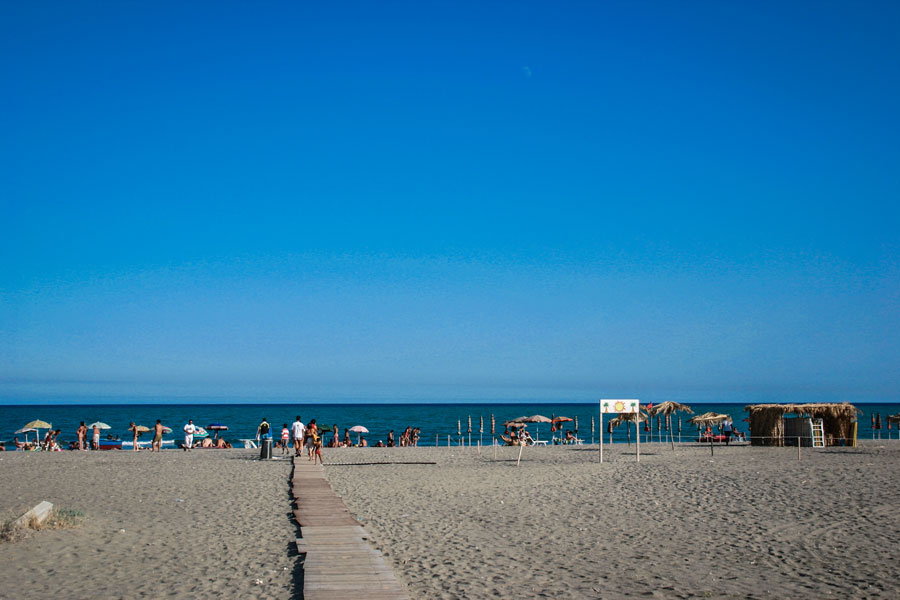
THREE GOOD REASONS TO VISITE POLICORO
1. THE PURE IONIAN SEA WATER
Unlike the other Lucanian beaches overlooking the Ionian Sea, Policoro's one is made of sand and pebbles. The water is deep on average and sometimes it is possible to catch sight of groups of dolphins swimming in the open sea. The seaboard is equipped with beach clubs alternating with stretches of free beach. There are also many accommodating facilities offering hospitality at moderate prices.
2. ANCIENT HERAKLEA
Policoro rises up a few kilometres away from the ruins of the ancient Greek polis of Heraklea. Close to the archeological park, it is possible to visit the Sirtide National Archeological Museum which safeguards grave goods, bronze armours, silver, golden and amber jewellery: proof of a glorious past. The museum adopted the Card (Mark) of quality services of MiBACT
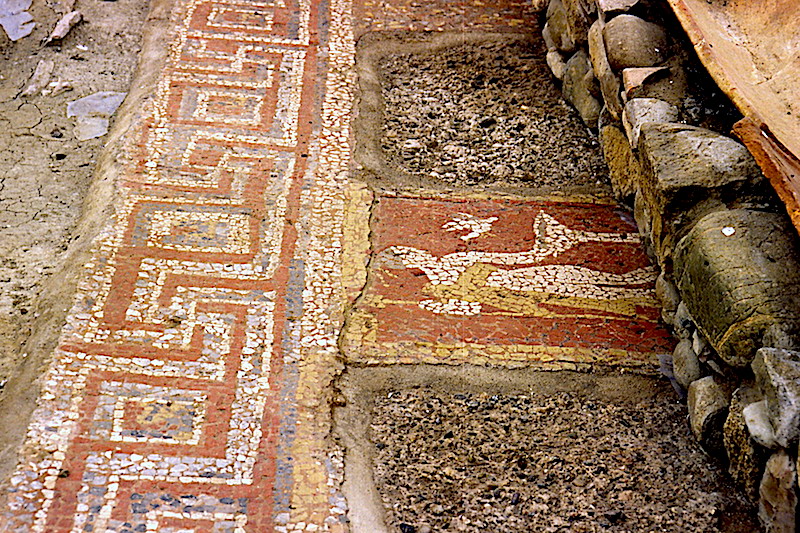
3. THE WEALTH OF FAUNA
Only a few kilometres away from the city, there is the WWF Policoro Heraklea Oasis, belonging to the vast Bosco Pantano di Policoro Natural Reserve (500 hectares). This is one of the last coastal forests of our country and represents an unmissable destination for birdwatching lovers.
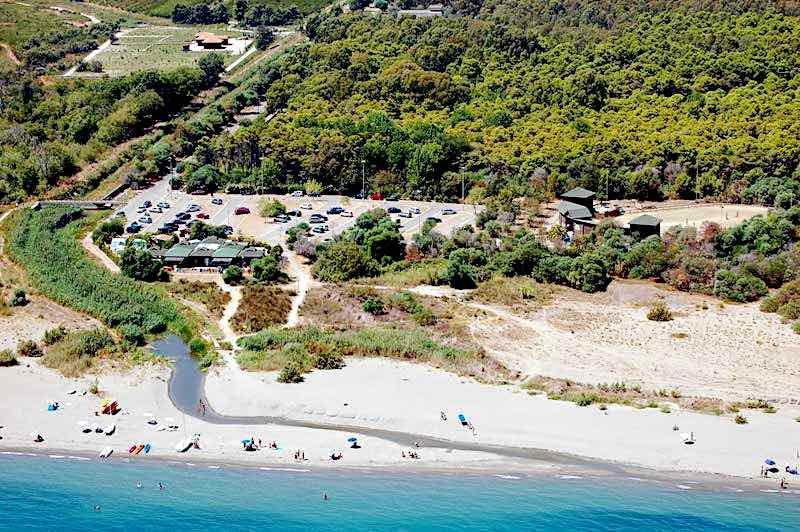
The Pantano of Policoro is in fact an important pit stop area for numerous migratory birds, of which roughly 170 species have been identified, such as the Major White Heron, The Grey Heron, The Eurasian Sponbill. The Oasis is shelter to many sea turtles, such as the Loggerhead sea turtle.
The park is open every day between 9 a.m. and 1 p.m. For guided tours booking is necessary.
BEFORE LEAVING FOR POLICORO READ OUR ITINERARY TO DISCOVER THE IONIC COST!
Waht to see in Pietrapertosa e Castelmezzano
Two amazing gems nestled between the spectacular Dolomitic Lucane, mountains that draw a unique landscape through their rocky contour. Two villages separated by a breath-taking wide valley, to be admired through an exciting and steep flight.
Pietrapertosa e Castelmezzano are essential stop-overs of your tour in Basilicata, by virtue of their key locations which make the villages look like some huge nativity scenes carved in the mountain.
A FLIGHT IN THE SHADOW OF DOLOMITI LUCANE
A poetic landscape that is exciting at the same time, thanks to "The Flight of the Angel", one of the most interesting attractions of the region. It consists of a steel cable connecting the two villages and allows visitors to fly between the two hamlets and admire the wide valley at speeds of up to 120 km/h, on a 800 metres overhang! A unique thrill beyond compare in whole of Italy.
Moreover, there are the historical centres: the U.S. Magazine Budget Travel described Castelmezzano as “the best place of the planet among all the ones which we have never even heard about", whereas Pietrapertosa boasts a Saracen fortress on the top of the village and an antique tradition linked to this ancient community. Both Pietrapertosa and Castelmezzano have been classified as two of “The most beautiful hamlets of Italy".
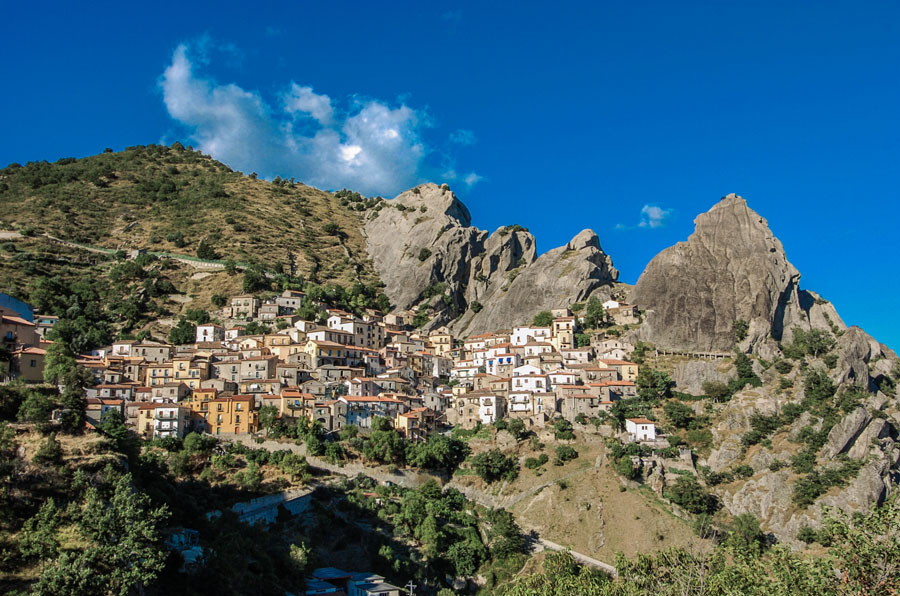
3 GOOD REASONS TO VISIT PIETRAPERTOSA AND CASTELMEZZANO
1. LE DOLOMITI LUCANE
Pietrapertosa and Castelmezzano are surrounded by Gallipoli Cognato Piccole Dolomiti Lucane Park, a green area extending to 27.027 hectares. Equipped for hiking, orienteering and guided tours, the park is an essential stop-over for italian bouldering lovers, thanks to the quality of the stone and the huge variety of areas to go rock climbing.
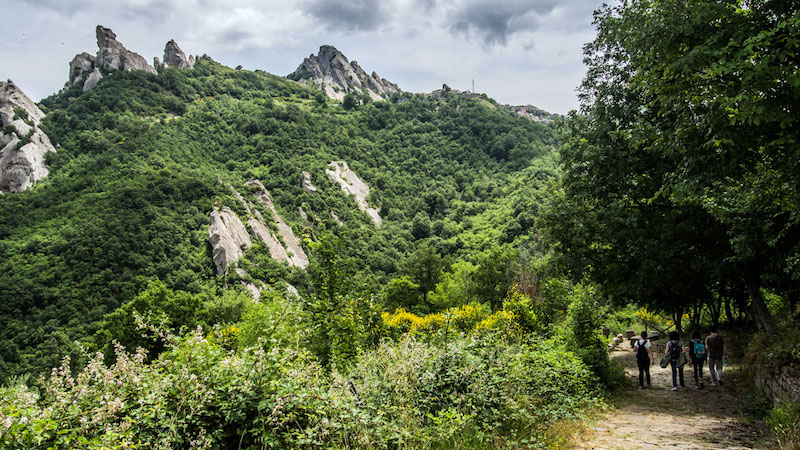
2. "THE FLIGHT OF THE ANGEL" AND THE IRON ROAD (VIA FERRATA)
The big attraction for thrill seekers is undoubtedly "The Flight of the Angel". An electrifying one and a half minute flight between the two villages at over 800 metres from the ground, you can travel solo or with a partner. The starting position is face down on the horizontal plan and in a few seconds you end up flying over a green stunning valley surrounded by rocky mountains. An excitement that lasts a little more than a minute but will stay in your heart your entire life!
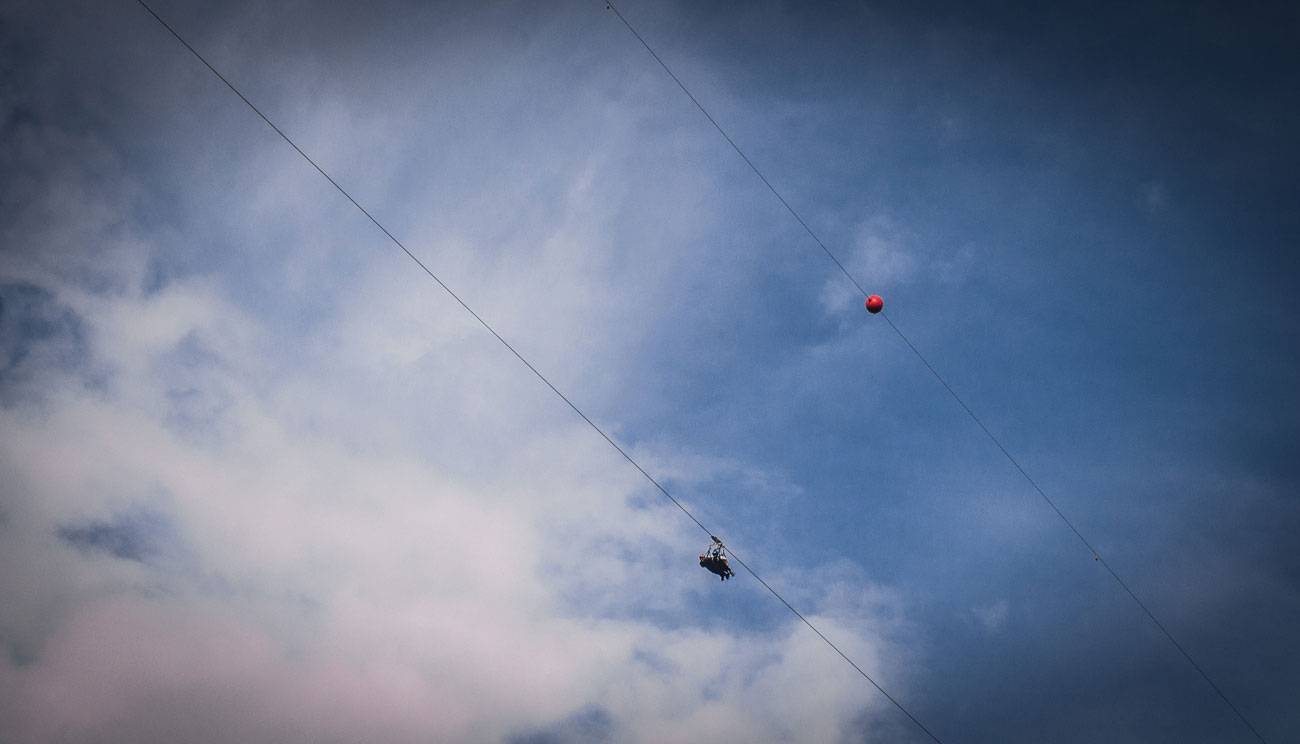
In addition, since 2015 mountains lovers visiting Pietrapertosa e Castelmezzano have been able to walk a via ferrata. It consists of two routes that twist and turn through the Dolomiti Lucane, along canals, walking paths and two Tibetan bridges.
FOR FURTER INFORMATION PLEASE READ OUR ITINERARY TO DISCOVER DOLOMITI LUCANE
3. ARABIC AND CRUSADING TRACKS
Inside these two villages, between rocky lanes and astonishing overhangings, there are hidden mysteries linked to the past. At the Crusades time, Castelmezzano was an important leg to knights going to Palestina. Marks of this past are spotted in symbols engraved on the facade of the ancient church Santa Maria dell’Olmo.
Whereas Castelmezzano is connected with Templars, Pietrapertosa has a Saracen history, testified by the structure of the buildings in the oldest neighbourhood, well known as the “Arabata”. This name comes from ruins of the ancient fortress built on the peak of the rocks and from a celebration that, once a year in summer nights, brings back paramours, fakirs and old fragrances all over the village alleys.
